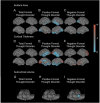This is a preprint.
Neural Correlates of Positive and Negative Formal Thought Disorder in Individuals with Schizophrenia: An ENIGMA Schizophrenia Working Group Study
- PMID: 37841855
- PMCID: PMC10571603
- DOI: 10.21203/rs.3.rs-3179362/v1
Neural Correlates of Positive and Negative Formal Thought Disorder in Individuals with Schizophrenia: An ENIGMA Schizophrenia Working Group Study
Update in
-
Differences in the neural correlates of schizophrenia with positive and negative formal thought disorder in patients with schizophrenia in the ENIGMA dataset.Mol Psychiatry. 2024 Oct;29(10):3086-3096. doi: 10.1038/s41380-024-02563-z. Epub 2024 Apr 26. Mol Psychiatry. 2024. PMID: 38671214 Free PMC article.
Abstract
Formal thought disorder (FTD) is a key clinical factor in schizophrenia, but the neurobiological underpinnings remain unclear. In particular, relationship between FTD symptom dimensions and patterns of regional brain volume deficiencies in schizophrenia remain to be established in large cohorts. Even less is known about the cellular basis of FTD. Our study addresses these major obstacles based on a large multi-site cohort through the ENIGMA Schizophrenia Working Group (752 individuals with schizophrenia and 1256 controls), to unravel the neuroanatomy of positive, negative and total FTD in schizophrenia and their cellular bases. We used virtual histology tools to relate brain structural changes associated with FTD to cellular distributions in cortical regions. We identified distinct neural networks for positive and negative FTD. Both networks encompassed fronto-occipito-amygdalar brain regions, but negative FTD showed a relative sparing of orbitofrontal cortical thickness, while positive FTD also affected lateral temporal cortices. Virtual histology identified distinct transcriptomic fingerprints associated for both symptom dimensions. Negative FTD was linked to neuronal and astrocyte fingerprints, while positive FTD was also linked to microglial cell types. These findings relate different dimensions of FTD to distinct brain structural changes and their cellular underpinnings, improve our mechanistic understanding of these key psychotic symptoms.
Conflict of interest statement
Confiicts of Interest The authors declare that there is no conflict of interest.
Figures


References
Publication types
Grants and funding
LinkOut - more resources
Full Text Sources
Miscellaneous

